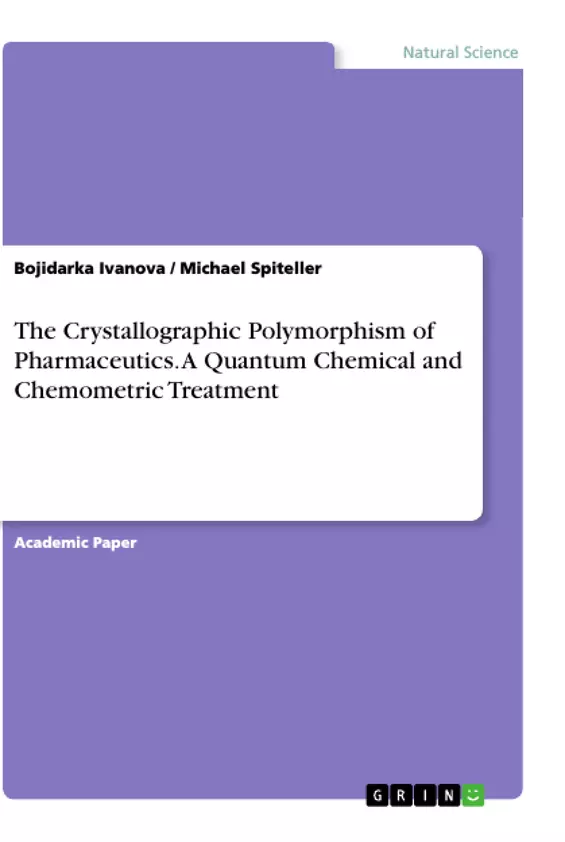In this work we discuss certain consideration for quantum chemical and chemometric assessing in the crystallographic polymorphism. It is aimed primarily at researchers in ‘Analytical chemistry’ and is designed to help readers’ understanding of the implications of the different quantum chemical theories in the chemical crystallography.
The term ‘polymorphism’ reflects molecular ability to crystalize in more than one structure. Since, properties of polymorphs can vary, their quantification becomes an important task to manufacturing pharmaceutics. It affects packing properties via molar volume and crystal density; optical properties and refractive index; electrical and thermal properties; conductivity; hydroscopicity; other differences associated with thermodynamics; kinetics; surface and mechanical properties, and more.
In order to make a complex prediction of correlation among ‘molecular structure’–‘electronic structure’–‘energetics’ using crystallographic and quantum chemical data it should be taken into consideration various polymorph modifications.
Inhaltsverzeichnis (Table of Contents)
- Acknowledgments
- Keywords
- Abstract
- Abbreviations and acronyms
- Introduction
- Crystallographic and theoretical analyses of polymorphs of aspirin and salicylic acid
- Crystallographic data of aspirin
- Quantum chemical treatment of aspirin
- Molecular and electronic structure of aspirin in its polymorphs
- Quantum chemical data of molecular models
- Crystallographic and theoretical analyses of crystals of 5–hydroxy thryptophan
- Crystallographic and quantum chemical analyses of crystals of biogenic amines
- Crystallographic and quantum chemical analyses of crystals of 2’,3’-o-isopropylideneadenosine
- Experimental section
- Analytical methods
- Materials and synthesis
- Theory/Computations
- Quantum chemical computations
- Chemometrics
- Conclusion
- References
Zielsetzung und Themenschwerpunkte (Objectives and Key Themes)
This work explores the relationship between molecular structure, electronic structure, and energetics of pharmaceutics. It focuses on the polymorphism of aspirin, using quantum chemical and chemometric methods. The study aims to understand how subtle electronic effects in polymorphs influence their energetic properties.
- Polymorphism of aspirin and its impact on energetic properties
- Application of quantum chemical methods to study electronic structure and energetics of polymorphs
- Chemometric analysis of energy trajectories to distinguish between different polymorphs
- Correlation between experimental crystallographic data and theoretical computations
- Assessment of the accuracy and reliability of computational methods in predicting energetic properties
Zusammenfassung der Kapitel (Chapter Summaries)
- Introduction: This chapter provides a general overview of polymorphism, highlighting its significance in pharmaceutical science. It introduces aspirin as a case study for investigating the intricate relationship between molecular structure, electronic structure, and energetics.
- Crystallographic and theoretical analyses of polymorphs of aspirin and salicylic acid: This chapter delves into the crystallographic and quantum chemical analyses of different polymorphs of aspirin, including salicylic acid as a structural analog. It presents a comprehensive study of the unit cell parameters, geometric variations, and electronic structure redistribution within the polymorphs.
- Crystallographic and theoretical analyses of crystals of 5–hydroxy thryptophan: This chapter explores the conformational analysis of 5–hydroxytryptophan, a key metabolite of the essential amino acid L-tryptophan. It examines the electronic structure and bond energies of the molecule in its crystalline state, comparing theoretical computations with experimental crystallographic data.
- Crystallographic and quantum chemical analyses of crystals of biogenic amines: This chapter investigates the electronic structure of biogenic amines, focusing on their protonation and coordination abilities. It analyzes the correlation between theoretical bond dissociation energies and experimental crystallographic electron densities.
- Crystallographic and quantum chemical analyses of crystals of 2’,3’-o-isopropylideneadenosine: This chapter examines the conformational polymorphism of 2',3'-o-isopropylideneadenosine, an important nucleoside involved in cellular processes. It utilizes quantum chemical computations to study the energetics of different molecular conformations and their relationship to crystallographic data.
- Experimental section: This chapter provides details on the analytical methods, materials, and theoretical computations employed in the study. It describes the experimental setup, data processing, and computational methodologies used to obtain the presented results.
Schlüsselwörter (Keywords)
The primary focus of this work lies on the crystallographic polymorphism of pharmaceutics. It utilizes quantum chemical and chemometric methods to assess the relationship between molecular structure, electronic structure, and energetics. The key concepts explored include polymorphism, pharmaceutics, quantum chemistry, crystallography, chemometrics, and electronic structure.
- Citation du texte
- Prof. Dr. Bojidarka Ivanova (Auteur), Michael Spiteller (Auteur), 2021, The Crystallographic Polymorphism of Pharmaceutics. A Quantum Chemical and Chemometric Treatment, Munich, GRIN Verlag, https://www.grin.com/document/1014678



